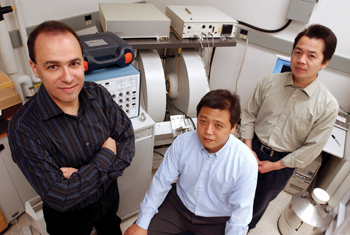
From left, Hassane Mchaourab, Ph.D., Jinhui Dong, graduate student, and Guangyong Yang, research assistant, have a paper published in Science.
by Dana Johnson
Molecular spies illuminate drug resistance proteins
Intricate details about a cellular protein, worked out by Vanderbilt University Medical Center scientists, may aid in the design of drugs that cells find 'irresistible.'
Resistance to antibiotics and chemotherapeutic agents is a growing medical concern. Multidrug resistance (MDR), in which cells are resistant to a number of unrelated drugs, is a particular problem in cancer chemotherapy.
One mechanism that underlies MDR results from a normally beneficial cellular process. Multidrug transporters, proteins embedded in the membrane of every cell from the most humble bacterium to the most sophisticated human cell, provide an important, nonspecific form of protection by purging toxic compounds from the cell.
“Multidrug transporters are a part of a defense mechanism universal to all organisms that allows them to remove cytotoxic molecules out of the cytoplasm,” said Hassane Mchaourab, Ph.D., associate professor of Molecular Physiology and Biophysics, the senior author on the study.
But, in doing so, they contribute to cells becoming resistant to some therapeutic drugs, most notably antibiotics and chemotherapy drugs.
In the May 13 issue of Science, Vanderbilt University Medical Center scientists reveal details about the structure and function of a multidrug transporter called MsbA that may help advance the design of new antibiotics and chemotherapy drugs that will be able to evade these transporters.
The first step in designing drugs that can defy these proteins is determining the structure and function of these transporters.
The basic structure of MsbA had previously been determined through crystal structure analysis, which provides a visual representation of an individual protein. However, a static model, which a crystal structure provides, reveals little about the way that protein functions.
“Crystal structure gives you a snapshot, but what you really want is a movie,” Mchaourab said.
Using a sophisticated molecular espionage technique called spin labeling, Mchaourab and colleagues attempted to make that movie.
First, they isolated MsbA protein from E. coli and inserted the pure protein into liposomes, synthetic membranes that mimic the protein's natural home in the cell membrane. Then, they sent in the spies.
“The basic strategy (in spin labeling) is to introduce probes into the protein, sort of molecular spies, and then receive signals from these molecular spies and decode them to describe the local structure around them.”
“By moving the spy across the entire protein structure, you are able to get a picture, a reasonable, medium resolution structure of the protein. Even more important, you can watch the change in the structure during the functional cycle.”
While their structure looked similar to the previous crystal structures except in functionally important details, the spies were able to reveal something the crystal structures couldn't — the opening and closing of the transporter in response to energy expenditure.
Multidrug transporters like MsbA pump molecules out of the cell using the energy released by the reaction of ATP (adenosine triphosphate), the cell's 'fuel' source, and water. This characteristic puts them in a special class of transporters, called ABC (ATP-binding cassette) transporters.
The researchers saw that ATP binding to the protein caused the chamber, a pore-like hole in the protein, to close from the inside of the cell outwards. This traps a molecule, like a drug or toxin, inside the chamber. At about the same time, the external part of the chamber begins to open, which allows the trapped molecule to be expelled from the cell.
These findings provide an important first step toward combating drug resistance in humans and infectious organisms. Humans have 47 types of multidrug ABC transporters, the most prominent and notorious being P-glycoprotein, which is responsible for resistance to chemotherapy.
Since the MsbA protein used in this study is about 35 percent identical to the P-glycoprotein found in humans, information gained about it should also apply to transporters involved in human drug resistance.
Additionally, MsbA is also the only ABC transporter in E. coli that is essential for the survival of the organism, which makes it a possible therapeutic target.
“The motivation for this work is to understand where the substrate binds and how it moves across so that one can start thinking about designing inhibitors of these molecules,” Mchaourab said.
“Whether it's resistance to infectious diseases or resistance to chemotherapy, the goal is to silence these proteins by designing inhibitors that bind tighter than the chemotherapeutic drugs or the antibiotics.”
The research was supported by a Vanderbilt Discovery Grant. Other Vanderbilt authors on the paper were Jinhui Dong, a graduate student and first author, and Guangyong Yang, research assistant in the Mchaourab lab.













